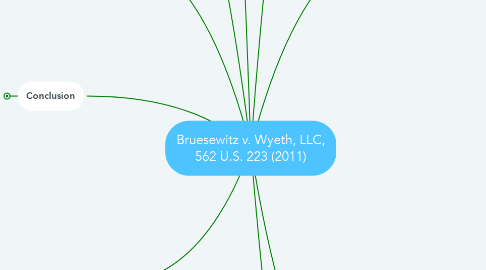
1. Facts
1.1. Parties Involved:
1.1.1. Russell and Robalee Bruesewitz and Wyeth Inc. (manufacturer vaccinations)
1.2. What happened: Hannah Bruesewitz received her six-month diphtheria tetanus and pertussis vaccine and two hours following that vaccination she started developing seizures and was hospitalized. She has continued to suffer from residual seizure disorder of which requires constant care.
2. Procedural History
2.1. During 1970's and 80's people became more concerned with risks of injury associated with vaccines; mostly concerned centered around the DTP vaccine which was blamed for child disabilities and developmental delays. Which lead to increased vaccination related tort litigation. This destabilized the DTP vaccination market causing domestic manufacturers to withdraw; the remaining manufacturer Lederle Laboratories (bought by Wyeth LLC) estimated that its tort liability exceeded its annual sales by a factor of 200. Additionally, compensation for vaccine related injuries by families was difficult to obtain due to litigation cost. Therefore, the drastic decline in parents wanting to get their children vaccinated was a source of concern for public health officials since vaccines prevent outbreaks of disease if a large percentage of the population is vaccinated. To stabilize the vaccine market and facilitate compensation for injuries the National Childhood Vaccination Injury Act was created.
2.2. Hannah Bruesewtiz was born on Oct. 20, 1991; administered DTP vaccination April 1992; 24 hours after receiving vaccination she experienced seizures; she suffered over 100 seizures during the next month of which she was diagnosed with "residual seizure disorder and developmental delay.
2.3. In 1995, Hannah's parents filed a vaccine injury petition in the United States Court of Federal Claims; alleging that Hannah suffered from one of the residual seizure disorders listed on the Table for side effects of the DTP vaccine; supported by the National Childhood Vaccination Act for families seeking compensation relief; these compensation awards were paid out of the fund created by an excise tax on each vaccine dose.
2.4. One month prior to the petition filed by the Bruesewitz, new regulations eliminated Hannah’s seizure disorder from the list of compensational injuries; thus, the family’s petition was denied.
2.5. The Bruesewitz elected to reject the the unfavorable judgement in October of 2005 and filed a lawsuit in Pennsylvania State Court. The Bruesewitz's filed suit of product liability action as a defective design against Wyeth Inc. Wyeth filed for a motion for summary judgement because there were not facts at issue. The motion was granted by the U.S. District Court for Eastern District of Pennsylvania on the grounds of the National Childhood Vaccine Act of 1988. The Bruesewitz's appealed the case and the U.S. Court of Appeals of the Third Circuit affirmed the ruling of the District Court. Certiorari was granted; the Supreme Court ruled that the National Childhood Vaccine Injury Act preempts all design defect claims against vaccine manufacturers brought by plaintiffs who seek compensation for injury or death caused by vaccine side effects.
3. Issue
3.1. Are vaccine manufacturers protected from product liability lawsuits in which the plaintiff is seeking compensation damages for serious health problems in children that transpired due vaccine side effects?
4. Rule of Law
4.1. National Childhood Vaccine Act of 1988 stated no vaccine manufacturer shall be liable in a civil action for damages arising from vaccine-related injury or death associated with the administration of a vaccine after October 1988, if the injury or death resulted from side effects that were unavoidable even though the vaccine was properly prepared and administered.
4.1.1. The term "unavoidable" with respect to the design of the drug implies that the design itself is not open to question; thus, tort litigation for defective design itself is covered by this act.
5. Analysis/Application
5.1. The Bruesewitz filed that the vaccine itself was defective after they were denied compensation for injury under the NCVA of 1988.
5.2. The Court Ruled that the NCVA of 1988 protects vaccine manufacturers against product liability claims because keeping vaccine rates up is good for the overall health of the population since vaccines protect against disease outbreak
5.2.1. Legal Reasoning: terminology used in the NCVA; "unavoidable" term implies that the overall design in itself is not open to question; implying there was proper manufacturing and warning and any remaining side effects including those involving in design defects are deemed to have been unavoidable because if the manufacturer would be held liable for failure to use a different design the word "unavoidable" would not work because the side affect of the vaccine could always have been avoidable by use of a different designed vaccine not containing the harmful element.
6. Conclusion
6.1. Bruesewitz filed for product liability that the vaccine was defective; however, because of the "unavoidable" terminology used in the NCVA product liability is void.
7. Impact
7.1. Kearl v. Lederle Laboratories (1985) Elizabeth Kearl's daughter contracted polio after receiving the polio vaccine; plaintiff filed that the vaccination was defective and jury ruled int the plaintiff's favor. Lederle Laboratories appealed and the judgement was reversed on the grounds that if manufacturers were held to strict liability it would prolong independent testing which will equally prolong suffering by denying needed cure or delaying its use
7.2. Feldman v. Lederle Laboratories (1993) Carol received antibiotics as an infant; the antibiotics discolored her permanent teeth; since the father did not notify the company in a timely matter of the effects that antibiotics had on his daughter the manufacturer was unaware of the side effects; thus, did not know its product was defective and under tort liability if the manufacturer was not notified of such circumstances then the manufacture could not disclose the warnings that the antibiotics had.
7.2.1. These cases present the bases for unavoidable defeats of products that is currently found in the NCVA of 1988 to protect vaccine manufacturers from tort liability.

